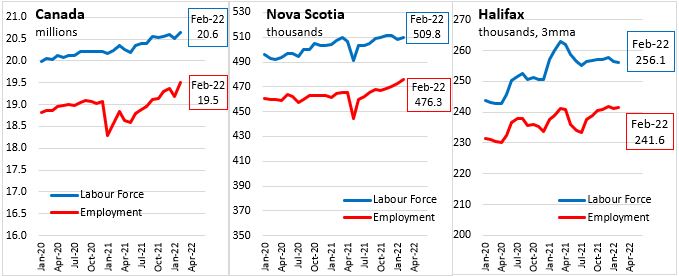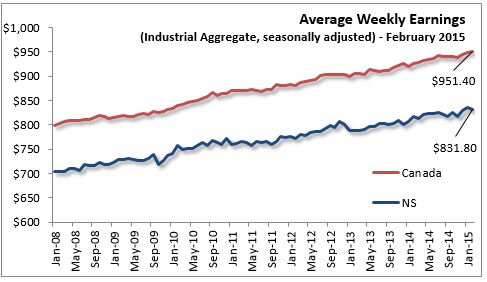To view previous releases, select one from the dropdown box:
Currently displaying information released on: March, 2022
LABOUR FORCE SURVEY - FEBRUARY 2022

MONTH OVER MONTH (Feb 2022 vs Jan 2022, seasonally adjusted)
In Nova Scotia,
- Labour force increased 0.3% (1,400) to 509,800
- Employment increased 0.8% (3,700) to 476,300
- Unemployment decreased 6.1% (2,200) to 33,600
- Unemployment Rate decreased 0.4 percentage points to 6.6%.
...
View complete article..
LABOUR MARKET TRENDS - FEBRUARY 2022
Labour force survey results reflect the period from February 13 to 19. Many restrictions implemented to contain the Omicron variant of COVID-19 were eased prior to this week.
Ages 15+ (February 2022 vs January 2021, seasonally adjusted)
Nova Scotia's seasonally adjusted employment increased by 3,700 (+0.8%) from January 2022 to February 2022, rising to 476,300. This is the fourth consecutive month of employment gains in Nova Scotia.
Rising...
View complete article..
JOB VACANCIES AND WAGES, Q4 2021
Statistics Canada has released its quarterly job vacancy and wage survey (unadjusted for seasonality) for the fourth quarter of 2021. Data collection activities were suspended from the start of the pandemic in March to September 2020. There remains a gap in the dataset for this survey.
This release provides data on the portion of jobs in a particular region, sector or occupation that are vacant. It also provides information on the wages offered on vacant positions as well a...
View complete article..
COMPENSATION OF EMPLOYEES Q4 AND ANNUAL 2021
With Q4 reference results, year-over-year (Q4 2021 vs Q4 2020) and annual (2021 vs. 2020) are showing the rebounds in economic activity from the unprecedented declines observed at the start of the COVID-19 pandemic.
Nova Scotia’s seasonally adjusted employee compensation (wages and salaries + employers’ social contributions) increased 1.3% in the fourth quarter of 2021 to $6.737 billion. The wages and salaries portion of employee compensation increased 1.1% to $5....
View complete article..
EMPLOYMENT INSURANCE FEBRUARY 2015
In February 2015, the number (seasonally adjusted) of Nova Scotians receiving regular Employment Insurance (EI) benefits increased by 580 persons (2.2%) from the previous month to 27,190 and increased by 160 persons (0.6%) over February 2014.
In February 2015, the number (seasonally adjusted) of Canadians receiving regular EI benefits increased by 9,940 persons (2.0%) from the previous month to 509,780 and declined by 3,470 (-0.7%) over February ...
View complete article..
EMPLOYMENT, EARNINGS AND HOURS, FEBRUARY 2015
Nova Scotians' average weekly earnings (including overtime, seasonally adjusted) decreased $3.98 per week (-0.5%) from January to $831.80 in February 2015. This is 1.9 per cent above the level in February of last year. Canadians' average weekly wages increased 0.3 per cent from January to $951.40 in February 2015, a 2.7 percent increase over February 2014.

View complete article..
|